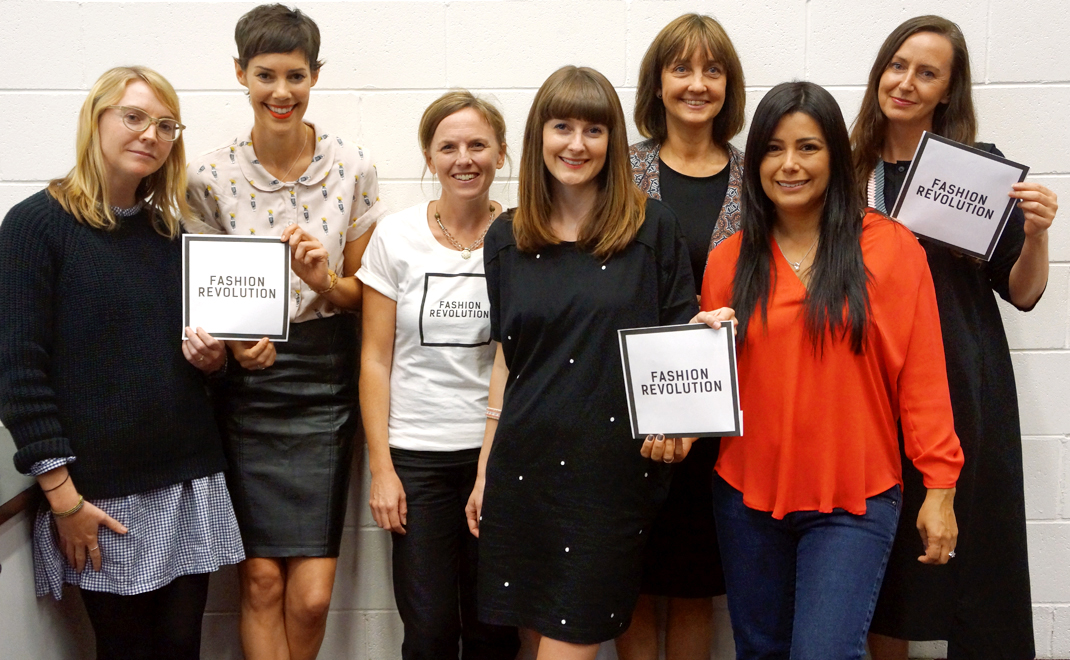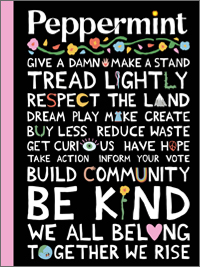
Who Made Your Clothes?

Have you ever pondered who created your clothes? What were their working conditions like? Were they paid a living wage? And what kind of impact did the process have on the planet? These, and many other questions about ethical manufacturing, transparency and sustainable fashion, were explored at the Peppermint Fashion Revolution event in Brisbane on Tuesday evening – held at QUT and featuring innovative outdoor apparel company Patagonia as special guests. Designers, fashion students and Peppermint readers gathered to watch the Australian premiere of ethical fashion film Traceable, followed by a panel discussion hosted by eco model Amanda Rootsey, featuring Wendy Savage, Social & Environmental Responsibility Manager at Patagonia USA, Alice Jones from Sinerji, Elisabeth Harvey from Nico Underwear, Cynthia Macnee from QUT CEA and Peppermint’s Kelley Sheenan and Rebecca Jamieson.
Wendy described Patagonia’s innovative approach to running a business, and their belief that all companies, large or small, can produce goods in a way that’s better for people and the planet. She talked about some of the areas where they are blazing a trail (and making it easy for others to follow in their footsteps), including their exclusive use of organic cotton, their new ‘traceable down’ initiative and their Worn Wear program, where old garments are repaired free of charge to prevent them going to landfill. At the core of the Patagonia philosophy is their focus on quality, as Wendy explained: “Part of our mission statement is to make the best products; to make sure they can last for a lifetime.” She also stressed that Patagonia are committed to transparency, and are always open to having conversations with their customers about what they can do better. And she was confident that running a sustainable business is possible for others: “When you do the right thing, everything else falls into place.”
Other key takeaways from the evening included…
“From range to range we’re using different materials and sourcing from different places, so for me it’s just been a matter of asking the hard questions and being demanding – and sometimes being annoying. Sometimes that means walking away from suppliers as well… but it’s a matter of having your standards and sticking to them.” – Elizabeth Harvey, Nico Underwear (pictured above)
“We want you to keep our garments for a lifetime… we spend a lot of time on quality and designing the best product. We have an iron-clad guarantee that if something happens to your garment we’ll fix it and send it back to you. So quality is very much at the centre of sustainability for us – we don’t want our garments ending up in a landfill.” – Wendy Savage
“That’s what Fashion Revolution Day is all about – take a piece of clothing that you love, take a selfie and tag a brand asking “who made my clothes?” Because it isn’t really up to consumers to know all of the back story… it’s up to the brands to take responsibility.” – Alice Jones, Sinerji
“If you want to have that scalability you need to think about your design, and how that can be replicated in a sustainable way.” – Cynthia Macnee, QUT CEA
Back in my day and my mom’s time, we had seamstresses and cobblers and people who would mend your pants – and your jeans were worn in a certain way, and you were proud of that… but that doesn’t happen anymore. You should feel good about what you already have.” – Wendy Savage, Patagonia
“Instead of boycotting and stepping away, everyone has to work together to create change.” – Kelley Sheenan, Peppermint Magazine
“Ask them the questions – that’s what Fashion Revolution Day is all about… and then it’s really easy to make that decision about ‘how does that match up with my personal ethics?'” – Elizabeth Harvey, Nico Underwear
“We think of traceability as a tool: it’s simply knowing where your stuff is made. So you trace it back, you find out where the factory is… And that’s the first step before you can implement any social or environmental compliance programs.” – Wendy Savage, Patagonia
“It’s no secret that Australia has some amazing Indigenous Aboriginal and Torres Strait Islander artisans… A lot of people overseas really look to Australia for this exciting and captivating ancient culture that we have here. So I hope that as part of everyone’s sustainability pathway, that they look in their own backyard (or way out back) for fine artists that they can work with.” – Cynthia Macnee, QUT CEA
I think people will look back on this period as the dark days of fashion: people exploiting other people, and buying cheap clothes and throwing them away. Now’s the time for change to start to happen; it’s an exciting time to be living.” – Rebecca Jamieson, Peppermint Magazine
“No one looks at pictures of Rana Plaza and think “yes, that’s how I want to consume.” They’re just really good at ignoring it. So the more people are forced to come to terms with what that buying choice actually means, the more they’re going to change.” – Elizabeth Harvey, Nico Underwear
“Things that can be a challenge at the beginning can actually form part of that really strong signature that defines and separates you from other brands, and aligns with your core values.” – Alice Jones, Sinerji
“[Advice for designers:] Even though the story is hugely important, don’t forget the design. Because long after you’ve got it home and you’ve forgotten what the story was, you’ll just care if you actually like the garment – if it fits you well, if it washes well. So the end of the day, it has to be a great design for the brand to survive.” – Kelley Sheenan, Peppermint Magazine
Follow the #fashrev hashtags tomorrow and remember to ask your favourite brands #whomademyclothes?


